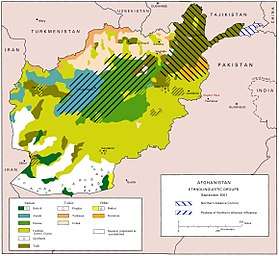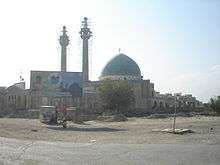Hazaras
The Hazaras (Persian: هزاره; Hazaragi: آزره) are an Persian-speaking ethnic group native to, and primarily residing in, the mountainous region of Hazarajat, in central Afghanistan. They speak the Hazaragi dialect of Persian[12][13][14]
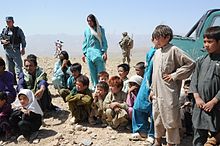 A group of Hazaras from Daykundi watching the U.S. Army Corps of Engineers inspect a project site in their province. | |
| Total population | |
|---|---|
| More than 8 million[1] | |
| Regions with significant populations | |
| 4 million (2009)[2][3] | |
| 900,000. Some ~ 40,000 Afghan citizens of Hazara descent in Pakistan (2005)[4][5] | |
| 500,000[6] | |
| 130,000[7] | |
| 200,000 (2014)[8] | |
| 10,300[9] | |
| 3,800[10] | |
| Languages | |
| Dari (Hazaragi) eastern varieties of Persian | |
| Religion | |
| Shia Islam (Twelver and Ismaili), with Sunni minorities (see Aimaq Hazara)[11] | |
| Related ethnic groups | |
| Aimaq people | |
| Part of a series on |
| Hazara people |
|---|
 |
|
About · The people · The land · Language · Culture · Diaspora · Persecutions · Tribes · Cuisine Politics · Writers · Poets · Military · Religion · Sports · Battles |
They are the third-largest ethnic group in Afghanistan,[15][16][17][18] and are also a significant minority group in neighboring Pakistan, where there is a population of between 650,000 and 900,000,[19][5] mostly in Quetta. Hazaras are considered to be one of the most oppressed groups in Afghanistan,[20] and their persecution dates back decades.[21]
Etymology
Babur, founder of the Mughal Empire in the early 16th century, records the name Hazara in his autobiography. He referred to the populace of a region called Hazaristan, located west of the Kabulistan region, east of Ghor, and north of Ghazni.[22]
The conventional theory is that the name Hazara derives from the Persian word for "thousand" (hezār هزار). It may be the translation of the Mongol word ming (or minggan), a military unit of 1,000 soldiers at the time of Genghis Khan.[23][24][25] With time, the term Hazar could have been substituted for the Mongol word and now stands for the group of people,[26] while the Hazaras in their native language call themselves (āzra آزره) and (azra ازره).
Origin
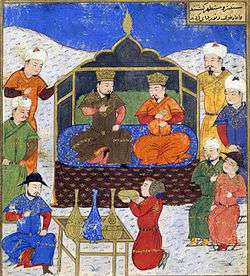
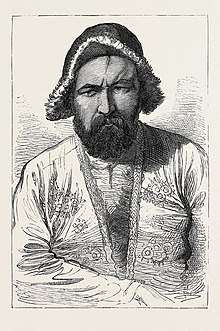
The origins of the Hazara have not been fully reconstructed. Significant Inner Asian descent—in historical context, Turkic and Mongol—is probable because their physical attributes,[27] facial bone structures and parts of their culture and language resemble those of Mongols and Central Asian Turks. Genetic analysis of the Hazara indicate partial Mongol ancestry.[28] Invading Mongols and Turco-Mongols mixed with the local Iranian population, forming a distinct group. For example, Nikudari Mongols settled in what is now Afghanistan and mixed with the native populations. A second wave of mostly Chagatai Mongols came from Central Asia and were followed by other Mongolic groups, associated with the Ilkhanate and the Timurids, all of whom settled in Hazarajat and mixed with the local population, forming a distinct group.
History
The Hazara identity in Afghanistan is believed by many to have originated in the aftermath of the 1221 Siege of Bamyan. The first mention of Hazara are made by Babur in the early 16th century and later by the court historians of Shah Abbas of the Safavid dynasty. It is reported that they embraced Shia Islam between the end of the 16th and the beginning of the 17th century, during the Safavid period.[29][30]
Hazara men along with tribes of other ethnic groups had been recruited and added to the army of Ahmad Shah Durrani in the 18th century.[31] Some claim that in the mid‑18th century Hazara were forced out of Helmand and the Arghandab District of Kandahar Province.
19th century
During the second reign of Dost Mohammad Khan in the 19th century, Hazara from Hazarajat began to be taxed for the first time. However, for the most part they still managed to keep their regional autonomy until the subjugation of Abdur Rahman Khan began in the late 19th century.
When the Treaty of Gandomak was signed and the Second Anglo-Afghan War ended in 1880, Abdur Rahman Khan set out a goal to bring Hazarajat and Kafiristan under his control. He launched several campaigns in Hazarajat due to resistance from the Hazara in which his forces committed atrocities. The southern part of Hazarajat was spared as they accepted his rule, while the other parts of Hazarajat rejected Abdur Rahman and instead supported his uncle, Sher Ali Khan. In response to this Abdur Rahman waged a war against tribal leaders who rejected his policies and rule.[29] This is known as the Hazara Uprisings. Abdur Rahman arrested Syed Jafar, chief of the Sheikh Ali Hazaras, and jailed him in Mazar-i-Sharif.
These campaigns had a catastrophic impact on the demographics of Hazaras causing 60% of them to perish and become displaced.[32]
20th century
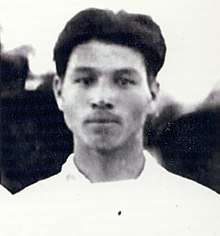
In 1901, Habibullah Khan, Abdur Rahman's successor, granted amnesty to all people who were exiled by his predecessor. However, the division between the Afghan government and the Hazara people was already made too deep under Abdur Rahman. Hazara continued to face severe social, economic and political discrimination through most of the 20th century. In 1933 King Mohammed Nadir Khan was assassinated by Abdul Khaliq Hazara. The Afghan government captured and executed him later, along with several of his innocent family members.[33]
Mistrust of the central government by the Hazaras and local uprisings continued. In particular, from 1945–1946, during Zahir Shah's rule, a revolt took place against new taxes that were exclusively imposed on the Hazara. The Kuchi nomads meanwhile not only were exempted from taxes, but also received allowances from the Afghan government.[29] The angry rebels began capturing and killing government officials. In response, the central government sent a force to subdue the region and later removed the taxes.

During the Soviet–Afghan War, the Hazarajat region did not see as much heavy fighting as other regions of Afghanistan. However, rival Hazara political factions fought. The division was between the Tanzáim-i nasl-i naw-i Hazara, a party based in Quetta, of Hazara nationalists and secular intellectuals, and the Islamist parties in Hazarajat.[29] By 1979, the Hazara-Islamist groups liberated Hazarajat from the central Soviet-backed Afghan government and later took entire control of Hazarajat away from the secularists. By 1984, after severe fighting, the secularist groups lost all their power to the Islamists.

As the Soviets withdrew in 1989, the Islamist groups felt the need to broaden their political appeal and turned their focus to Hazara ethnic nationalism.[29] This led to establishment of the Hizb-i-Wahdat, an alliance of all the Hazara resistance groups (except the Harakat-i Islami). In 1992 with the fall of Kabul, the Harakat-i Islami took sides with Burhanuddin Rabbani's government while the Hizb-i-Wahdat took sides with the opposition. The Hizb-i-Wahdat was eventually forced out of Kabul in 1995 when the Taliban movement captured and killed their leader Abdul Ali Mazari. With the Taliban's capture of Kabul in 1996, all the Hazara groups united with the new Northern Alliance against the common new enemy. However, it was too late and despite the fierce resistance Hazarajat fell to the Taliban by 1998. The Taliban had Hazarajat totally isolated from the rest of the world going as far as not allowing the United Nations to deliver food to the provinces of Bamyan, Ghor, Maidan Wardak, and Daykundi.[34]
.jpg)
Hazaras have also been a significant role in the creation of Pakistan. One such Hazara was Qazi Muhammad Essa of the Sheikh Ali tribe, who had been close friends with Muhammad Ali Jinnah, having had met each other for the first time whilst they were studying in London. He had been the first from his native province of Balochistan to obtain a Bar-at-Law degree and had helped set up the All-India Muslim League in Balochistan. [35] [36]
Though Hazara played a role in the anti-Soviet movement, other Hazara participated in the new communist government, which actively courted Afghan minorities. Sultan Ali Kishtmand, a Hazara, served as prime minister of Afghanistan from 1981–1990 (with one brief interruption in 1988).[37] The Ismaili Hazara of Baghlan Province likewise supported the communists, and their pir (religious leader) Jaffar Naderi led a pro-Communist militia in the region.[38]
During the years that followed, Hazara suffered severe oppression and many ethnic massacres, genocides and pogroms were carried out by the predominantly ethnic Pashtun Taliban and are documented by such groups the Human Rights Watch.[39] These human rights abuses not only occurred in Hazarajat, but across all districts controlled by the Taliban. Particularly after their capture of Mazar-i-Sharif in 1998, where after a massive killing of some 8,000 civilians, the Taliban openly declared that the Hazara would be targeted.
21st century
Following the 11 September 2001 attacks in the United States, British and American forces invaded Afghanistan. Many Hazara have become leaders in today's newly emerging Afghanistan.[40] Hazara have also pursued higher education, enrolled in the army, and many have top government positions.[41] For example, Mohammad Mohaqiq, a Hazara from the Hizb-i-Wahdat party, ran in the 2004 presidential election in Afghanistan, and Karim Khalili became the Vice President of Afghanistan. A number of ministers and governors are Hazara, including Sima Samar, Habiba Sarabi, Sarwar Danish, Sayed Hussein Anwari, Abdul Haq Shafaq, Sayed Anwar Rahmati, Qurban Ali Oruzgani. The mayor of Nili in Daykundi Province is Azra Jafari, who became the first female mayor in Afghanistan. Some other notable Hazara include: Sultan Ali Keshtmand, Abdul Wahed Sarābi, Ghulam Ali Wahdat, Sayed Mustafa Kazemi, Muhammad Arif Shah Jahan, Ghulam Husain Naseri, Abbas Noyan, Abbas Ibrahim Zada, Ramazan Bashardost, Ahmad Shah Ramazan, Ahmad Behzad, Nasrullah Sadiqi Zada Nili. The Parliament of Afghanistan is 25% made up of ethnic Hazara, which represents 61 members.[42]
Although Afghanistan has been historically one of the poorest countries in the world, the Hazarajat region has been kept even more poor from development by past governments. Since ousting the Taliban in late 2001, billions of dollars have poured into Afghanistan for reconstruction and several large-scale reconstruction projects took place in Afghanistan from August 2012. For example, there have been more than 5000 kilometers of road pavement completed across Afghanistan, of which little was done in central Afghanistan Hazarajat. On the other hand, the Band-e Amir in the Bamyan Province became the first national park of Afghanistan. The road from Kabul to Bamyan was also built, along with new police stations, government institutions, hospitals, and schools in the Bamyan Province, Daykundi Province, and the others. The first ski resort of Afghanistan was also established in Bamyan Province.[43][44]
An indication of discrimination is that Kuchis (Pashtun nomads who have historically been migrating from region to region depending on the season) are allowed to use Hazarajat pastures during the summer season. It is believed that allowing the Kuchis to use some of the grazing land in Hazarajat began during the rule of Abdur Rahman Khan.[45] Living in mountainous Hazarajat, where little farm land exists, Hazara people rely on these pasture lands for their livelihood during the long and harsh winters. In 2007 some Kuchi nomads entered into parts of Hazarajat to graze their livestock, and when the local Hazara resisted, a clash took place and several people on both sides died using assault rifles. Such events continue to occur, even after the central government was forced to intervene, including President Hamid Karzai. In late July 2012, a Hazara police commander in Uruzgan province reportedly rounded up and killed 9 Pashtun civilians in revenge for the death of two local Hazara. The matter is being investigated by the Afghan government.[45]
The drive by President Hamid Karzai after the Peace Jirga to strike a deal with Taliban leaders caused deep unease in Afghanistan's minority communities, who fought the Taliban the longest and suffered the most during their rule. The leaders of the Tajik, Uzbek and Hazara communities, vowed to resist any return of the Taliban to power, referring to the large-scale massacres of Hazara civilians during the Taliban period.[46]
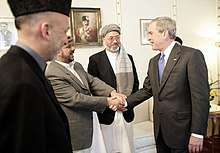 Karim Khalili, 2nd Vice President of Afghanistan (with turban) is standing next to Mohammed Fahim, George W. Bush, facing Hamid Karzai.
Karim Khalili, 2nd Vice President of Afghanistan (with turban) is standing next to Mohammed Fahim, George W. Bush, facing Hamid Karzai.
 Nasrullah Sadiqi Zada Nili is the representative of the Daykundi people in the fifteenth and sixteenth parliamentary sessions of the Afghanistan Parliament.
Nasrullah Sadiqi Zada Nili is the representative of the Daykundi people in the fifteenth and sixteenth parliamentary sessions of the Afghanistan Parliament.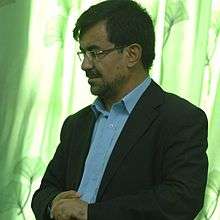 Sayed Anwar Rahmati is a politician and the current governor of Daykundi Province of Afghanistan.
Sayed Anwar Rahmati is a politician and the current governor of Daykundi Province of Afghanistan.
Genetics
Genetically, the Hazara are a mixture of western Eurasian and eastern Eurasian components, i.e. racially Eurasian. Genetic research suggests that the Hazaras of Afghanistan cluster closely with the Uzbek population of the country, while both groups are at a notable distance from Afghanistan's Tajik and Pashtun populations.[47] There is evidence of both a patrimonial and maternal relation to Turkic Peoples and Mongols amongst some Hazaras.[48]
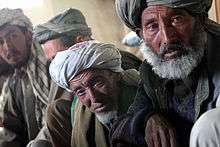
East Eurasian male and female ancestry is supported by studies in genetic genealogy as well. East Asian maternal haplogroups (mtDNA) make up about 35%, suggesting that the male descendants of Turkic and Mongolic peoples were accompanied by women of East Asian ancestry, though the Hazaras as a whole have mostly west Eurasian mtDNA.[49] Women of Non-East Asian mtDNA in Hazaras are at about 65%, most which are West Eurasians and some South Asian.[50]
The most frequent paternal haplogroups found amongst the Pakistani Hazara were haplogroup C-M217 at 40%(10/25) and Haplogroup R1b at 32%[51] (8/25).
One study about paternal DNA haplogroups of the Afghanistan shows that the Y-DNA haplogroups R1a and C-M217 are the most common haplogroups, followed by J2-M172 and L-M20. Some Hazaras also have the haplogroup R1a1a-M17, E1b1b1-M35, L-M20 and H-M69, which are common in Tajiks, Pashtuns as well as Indian populations. In one study, a small minority had the haplogroup B-M60, normally found in East Africa,[52] and in one mtDNA study of Hazara, mtDNA Haplogroup L (which is of African origin) was detected at a frequency of 7.5%.[53]
A recent study shows that the Uyghurs are closely related to the Hazaras. The study also suggests a small but notable East Asian ancestry in other populations of Pakistan and India.[54]
Demographics
Geographic distribution
The vast majority of Hazaras live in Hazarajat, and many others live in the cities, including in neighboring countries or abroad. The latest World Factbook estimates show that Hazara make up nine percent of the total Afghanistan population but some sources claim that they are about 20 percent.[26][40][55]
Diaspora
Alessandro Monsutti argues, in his recent anthropological book,[56] that migration is the traditional way of life of the Hazara people, referring to the seasonal and historical migrations which have never ceased and do not seem to be dictated only by emergency situations such as war.[57] Due to the decades of war in Afghanistan and the sectarian violence in Pakistan, many Hazaras left their communities and have settled in Australia, New Zealand, Canada, the United States, the United Kingdom and particularly the Northern European countries such as Sweden and Denmark. Some go to these countries as exchange students while others through human smuggling, which sometimes costs them their lives. Since 2001, about 1,000 people have died in the ocean while trying to reach Australia by boats from Indonesia.[58] Many of these were Hazaras, including women and small children who could not swim. The notable case was the Tampa affair in which a shipload of refugees, mostly Hazara, was rescued by the Norwegian freighter MV Tampa and subsequently sent to Nauru.[59] New Zealand agreed to take some of the refugees and all but one of those were granted stay.
Hazara in Pakistan
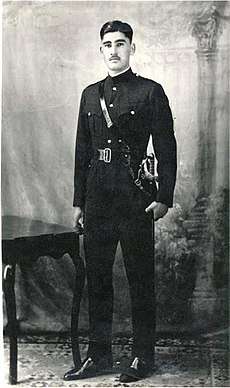
During the British expansion in the 19th century, Hazaras worked during the winter months in coal mines, road construction and in other menial labor jobs in some cities of what is now Pakistan. The earliest record of Hazara in the areas of Pakistan is found in Broadfoot's Sappers company from 1835 in Quetta. This company had also participated in the First Anglo-Afghan War. Some Hazara also worked in the agriculture farms in Sindh and construction of Sukkur barrage. Haider Ali Karmal Jaghori was a prominent political thinker of the Hazara people in Pakistan, writing about the political history of Hazara people. His work Hazaraha wa Hazarajat Bastan Dar Aiyna-i-Tarikh was published in Quetta in 1992, and another work by Aziz Tughyan Hazara Tarikh Milli Hazara was published in 1984 in Quetta.
Most Pakistani Hazaras today live in the city of Quetta, in Balochistan, Pakistan. Localities in the city of Quetta with prominent Hazara populations include Hazara Town and Mehr Abad and Hazara tribes such as the Sardar are exclusively Pakistani. Literacy level among the Hazara community in Pakistan is relatively high compare to the Hazaras of Afghanistan, and they have integrated well into the social dynamics of the local society. Saira Batool, a Hazara woman, was one of the first female pilots in Pakistan Air Force. Other notable Hazara include Qazi Mohammad Esa, General Musa Khan Hazara, who served as Commander in Chief of the Pakistani Army from 1958 to 1968, Air Marshal Sharbat Ali Changezi, Hussain Ali Yousafi, the slain chairman of the Hazara Democratic Party,[60] Syed Nasir Ali Shah, MNA from Quetta and his father Haji Sayed Hussain Hazara who was a senator and member of Majlis-e-Shura during the Zia-ul-Haq era.
Despite all of this, Hazaras are often targeted by militant groups such as the Lashkar-e-Jhangvi and others. "Activists say at least 800-1,000 Hazaras have been killed since 1999 and the pace is quickening. More than one hundred have been murdered in and around Quetta since January, according to Human Rights Watch."[58] The political representation of the community is served by Hazara Democratic Party, a secular liberal democratic party, headed by Abdul Khaliq Hazara.[61][62]
Hazara in Iran
Hazaras are mostly known in Iran as Khawaris and Barbaris. Over the many years as a result of political unrest in Afghanistan some Hazaras have migrated to Iran. The local Hazara population has been estimated at 500,000 people of which at least one third have spent more than half their life in Iran.[6]
They have complained of discrimination in Iran. In March 2011, Eurasia Daily Monitor reported that representatives of Hazara community in Iran have asked Mongolia to intervene in supporting their case with Iranian government and prevent Iranian forced repatriation to Afghanistan.[63]
Culture
The Hazara, outside of Hazarajat, have adopted the cultures of the cities where they dwell, resembling customs and traditions of the Afghan Tajiks and Pashtuns. Traditionally the Hazara are highland farmers and although sedentary, in the Hazarajat, they have retained many of their own customs and traditions, some of which are more closely related to those of Central Asia than to those of the Afghan Tajiks. For instance, many Hazara musicians are widely hailed as being skilled in playing the dambura, a native, regional lute instrument similarly found in other Central Asian nations such as Tajikistan, Uzbekistan and Kazakhstan. The Hazara live in houses rather than tents; Aimaqs and Aimaq Hazaras in tents rather than houses.[64]
Food and cuisine
Language
Hazara people living in Hazarajat (Hazaristan) areas speak the Hazaragi[14][65] language of Afghanistan, which is infused with a significant number of Altaic loan words including Mongolic and Turkic.[55][66][67] The primary differences between Dari and Hazaragi are the accent[13] and Hazaragi's greater array of some Altaic loanwords.[14] Despite these differences, Hazaragi is mutually intelligible with Dari,[12] one of the official languages of Afghanistan.
Many of the urban Hazara in the larger cities such as Kabul and Mazar-i-Sharif no longer speak Hazaragi but speak standard literary Dari (usually the Kābolī dialect) or other regional varieties of Dari (for example the Khorāsānī dialect in the western region of Herat).
Religion
Hazara are predominantly Shi'a Muslims, mostly of the Twelver sect[69] and some Ismaili.[11] Since the majority of Afghans practice Sunni Islam, this may have contributed to the discrimination against the Hazara.[26] Hazara probably converted to Shi'ism during the first part of the 16th century, in the early days of the Safavid Dynasty.[70] Nonetheless, some small numbers of Hazara are Sunni, such as the Aimaq Hazaras and Taimuris.[11] Sunni Hazara have been attached to non-Hazara tribes (such as Taimuris), while the Ismaili Hazara have always been kept separate from the rest of the Hazara on account of religious beliefs and political purposes.
Hazara tribes
The Hazara people have been organized by various tribes. They include Sheikh Ali, Jaghori, Ghaznichi, Muhammad Khwaja, Behsudi, Uruzgani, Daikundi, Daizangi, Turkmani, Dai Mirdadi and others. The different tribes come from regions such as Parwan, Bamyan, Ghazni, Ghor, Urozgan, Daykundi and Maidan Wardak and have spread outwards from Hazarajat (Main City) into Kabul and other parts of Afghanistan.
Sports
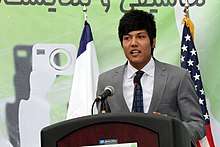
Many Hazaras engaged varieties of sports, including football, volleyball, wrestling, martial arts, boxing, karate, taekwondo, judo, wushu and more. Pahlawan Ebrahim Khedri, 62 kg wrestler, was the national champion for two decades in Afghanistan.[71] Rohullah Nikpai, won a bronze medal in Taekwondo in the Beijing Olympics 2008, beating world champion Juan Antonio Ramos of Spain 4–1 in a play-off final. It was Afghanistan's first-ever Olympic medal. He then won a second Olympic medal for Afghanistan in the London 2012 games. Afghanistan's first female Olympic athlete Friba Razayee, competed in judo at the 2004 Athens Olympics, but was eliminated in the first round of competition.
Other famous Hazara athlete Syed Abdul Jalil Waiz, was the first ever badminton player representing Afghanistan in Asian Junior Championships in 2005 where he produced the first win for his country against Iraq, with 15–13, 15–1. He participated in several international championships since 2005 and achieved victories against Australia, Philippines and Mongolia. Hamid Rahimi is a new boxer from Afghanistan and lives in Germany. Hazara famous football players are Zohib Islam Amiri, Ali Hazara, Moshtagh Yaghoubi, Mustafa Amini and Rahmat Akbari. Zohib Islam Amiri, is currently playing for the Afghanistan national football team.[72]
A Pakistani Hazara named Abrar Hussain, a former Olympic boxer, served as deputy director general of the Pakistan Sports Board. He represented Pakistan three times at the Olympics and won a gold medal at the 1990 Asian Games in Beijing. Some Hazara from Pakistan have also excelled in sports and have received numerous awards particularly in boxing, football and in field hockey. Qayum Changezi, a legendary Pakistani football player, was a Hazara. New Hazara youngsters are seen to appear in many sports in Pakistan mostly from Quetta. Rajab Ali Hazara, who is leading under 16 Pakistan Football team as captain.[73]
Notable people
Gallery

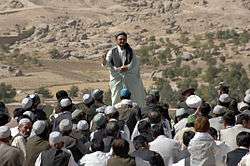 A gathering of Hazaras on the final day of Ramadan in Daykundi Province of Afghanistan
A gathering of Hazaras on the final day of Ramadan in Daykundi Province of Afghanistan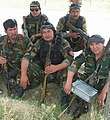 Hazara soldiers in Afghanistan
Hazara soldiers in Afghanistan A Hazara little girl from Bamyan
A Hazara little girl from Bamyan Hazara girl in central Afghanistan
Hazara girl in central Afghanistan
See also
Notes and references
- James B. Minahan (10 Feb 2014). Ethnic Groups of North, East, and Central Asia: An Encyclopedia. ABC-CLIO. p. 99. ISBN 978-1-61069-018-8.
Due to a lack of census statistics, estimates of the total Hazara population range from five million to more than eight million.
- https://www.cia.gov/library/publications/the-world-factbook/fields/401.html#AF%7Caccess-date= 4 December 2019}}
- https://data.worldbank.org/country/afghanistan
- Census of Afghans in Pakistan 2005, UNHCR Statistical Summary Report (retrieved August 14, 2016)
- Yusuf, Imran (5 October 2011). "Who are the Hazara?". Tribune. Retrieved 1 September 2016.
- Smyth, Phillip (3 June 2014). "Iran's Afghan Shiite Fighters in Syria". The Washington Institute for Near East Policy. Retrieved 22 June 2017.
- "Austria holds refugee talks as young Hazaras flee persecution to make 'dangerous' journey to Europe – ABC News (Australian Broadcasting Corporation)". mobile.abc.net.au. 2016-02-29. Retrieved 2017-08-19.
- Nowell, Laurie (2014-07-16). "The Hazaras of Dandenong". The Age. Retrieved 2017-08-19.
- The population of people with descent from Afghanistan in Canada is 48,090. Hazara make up an estimated 30% of the population of Afghanistan depending to the source. The Hazara population in Canada is estimated from these two figures. Ethnic origins, 2006 counts, for Canada
- Afghan Hazaras' new life in Indonesia: Asylum-seeker community in West Java is large enough to easily man an eight-team Afghan football league, Al Jazeera, 21 March 2014, retrieved 5 August 2016
- The Afghans, Their History and Culture, Religion Archived 2010-12-28 at the Wayback Machine
- "Attitudes towards Hazaragi". pp. 1–2. Retrieved June 5, 2014.
- Schurmann, Franz (1962). The Mongols of Afghanistan: An Ethnography of the Moghôls and Related Peoples of Afghanistan. The Hague, Netherlands: Mouton. p. 17. OCLC 401634.
- Kieffer, Charles M. "HAZĀRA" [iv. Hazāragi dialect]. Encyclopædia Iranica. Retrieved August 22, 2017.
- Dupree, L. (2006). "AFGHANISTAN" [iv. Ethnography]. Encyclopædia Iranica (Online ed.).
- "Afghanistan: 31,822,848 (July 2014 est.) @ 9% (2014)". The World Factbook. Central Intelligence Agency. Retrieved July 17, 2015.
- Hyder, Kamal (November 12, 2011). "Hazara community finds safe haven in Peshawar". Al Jazeera English. Retrieved November 12, 2011.
- "COUNTRY PROFILE: AFGHANISTAN" (PDF). Library of Congress Country Studies. Retrieved August 22, 2017.
- Malik Ayub Sumbal. "The Plight of the Hazaras in Pakistan". The Diplomat. Retrieved August 22, 2017.
- Emadi, Hafizullah (September 1997). "The Hazaras and their role in the process of political transformation in Afghanistan". Central Asian Survey. 16 (3): 363–387. doi:10.1080/02634939708400997.
Hazaras are one of the oppressed and dispossessed national minority communities of the country.
- Mousavi, S. A. (October 24, 2018). The Hazaras of Afghanistan. Routledge.
- Babur, Z. M. (1987). Babur-nama. Lahore. pp. 300, 207, 214, 218, 221, 251–53.
- Schurmann, H. F. (1962). The Mon-gols of Afghanistan: An Ethnography of the Moghôls and Related Peoples of Afghanistan. La Haye. p. 115.
- Poladi, Hassan (1989). The Hazâras. Stockton. p. 22.
- Mousavi, Sayed Askar (1998). The Hazaras of Afghanistan [An Historical, Cultural, Economic and Political Study]. Richmond. pp. 23–25.
- Khazeni, Arash; Monsutti, Alessandro; Kieffer, Charles M. (December 15, 2003). "HAZĀRA". Encyclopædia Iranica (Online ed.). United States. Retrieved December 23, 2007.
- Blunden, Jane (2014). Mongolia. Bradt Travel Guides. p. 68. ISBN 978-1-84162-416-7.
- Hartl, Daniel L.; Jones, Elizabeth W. (2009). Genetics: Analysis of Genes and Genomes. p. 262. ISBN 978-0-7637-5868-4.
- "HAZĀRA: ii. HISTORY". Alessandro Monsutti (Online ed.). United States: Encyclopædia Iranica. December 15, 2003. Retrieved 9 August 2012.
- Sarabi, Humayun (2005). "Politics and Modern History of Hazara" [Sectarian Politics in Afghanistan]. Fletcher School of Law and Diplomacy. Archived from the original on 2011-09-18. Retrieved 2011-11-02.
- "Ahmad Shah and the Durrani Empire". Library of Congress Country Studies on Afghanistan. 1997. Retrieved 2010-08-25.
- دلجو, عباس (2014). تاریخ باستانی هزاره ها. کابل: انتشارات امیری. ISBN 978-9936801509.
- Runion, Meredith L. (2017). The History of Afghanistan, 2nd edition. ABC-CLIO-LLC. p. 124. ISBN 978-1-61069-778-1.
- Rashid, Ahmed (March 1, 2001). Taliban: Militant Islam, Oil and Fundamentalism in Central Asia (Paperback ed.). New Haven, CT: Yale University Press. ISBN 978-0-300-08902-8.
- https://www.dawn.com/news/1486499
- https://dailytimes.com.pk/626799/qazi-muhammad-isa-and-the-reference-against-justice-qazi-faez-isa/
- Fida Yunas, S. (2008). Pg 33. Sultan Ali Kishtmand had remained Prime Minister of Afghanistan from 10 January 1981 to 26 May 1990, with a brief break of about nine months, when Dr Hassan Sharq replaced him from 20 June 1988 to .... Retrieved 2012-07-30.
- Williams, Brian Glyn (2011-09-22). Afghanistan Declassified: A Guide to America's Longest War – Brian Glyn Williams – Google Books. ISBN 978-0-8122-0615-9. Retrieved 2012-07-30.
- Human Rights Watch (February 2001). "Afghanistan: massacres of Hazaras". hrw.org. Retrieved December 27, 2007.
- Larson, Marisa (Jun 17, 2008). "Hazara People". National Geographic. Retrieved August 9, 2012.
- Sappenfield, Mark (August 6, 2007). "Afghanistan's success story: The liberated Hazara minority". Christian Science Monitor. Retrieved December 27, 2007.
- "Many Karzai rivals find way to Parliament". Pajhwok.com. 2011-01-22. Archived from the original on 2012-03-13. Retrieved 2012-07-30.
- "(27 February 2012) Afghanistan set to host second national ski race. wanderlust.co.uk". Wanderlust.co.uk. Archived from the original on 4 August 2017. Retrieved 30 October 2017.
- Levinson, Charles (6 March 2012). Since Skiing Came to Afghanistan, It Has Been Pretty Much All Downhill. wsj.com
- Afghan nomad clashes raise fears of ethnic strife
- "Afghan Overture to Taliban Aggravates Ethnic Tensions". The New York Times, 27 June 2010.
- Haber, M; Platt, DE; Ashrafian Bonab, M; et al. (2012). "Afghanistan's Ethnic Groups Share a Y-Chromosomal Heritage Structured by Historical Events". PLoS ONE. 7 (3): e34288. Bibcode:2012PLoSO...734288H. doi:10.1371/journal.pone.0034288. PMC 3314501. PMID 22470552.
- Rosenberg, Noah A.; et al. (December 2002). "Genetic Structure of Human Populations". Science. New Series. 298 (5602): 2381–85. Bibcode:2002Sci...298.2381R. doi:10.1126/science.1078311. PMID 12493913.
- Quintana-Murci, L; Chaix, R; Wells, RS; et al. (May 2004). "Where West Meets East: The Complex mtDNA Landscape of the Southwest and Central Asian Corridor". The American Journal of Human Genetics. 74 (5): 827–45. doi:10.1086/383236. PMC 1181978. PMID 15077202.
- Quintana-Murci, L; Chaix, R; Wells, RS; et al. (May 2004). "Figure 1: Where west meets east: the complex mtDNA landscape of the southwest and Central Asian corridor". Am. J. Hum. Genet. 74 (5): 827–45. doi:10.1086/383236. PMC 1181978. PMID 15077202.
- Lkhagvasuren, Gavaachimed; Shin, Heejin; Lee, Si Eun; Tumen, Dashtseveg; Kim, Jae-Hyun; Kim, Kyung-Yong; Kim, Kijeong; Park, Ae Ja; Lee, Ho Woon; Kim, Mi Jin; Choi, Jaesung; Choi, Jee-Hye; Min, Na Young; Lee, Kwang-Ho (14 September 2016). "Molecular Genealogy of a Mongol Queen's Family and Her Possible Kinship with Genghis Khan". PLOS ONE. 11 (9): e0161622. Bibcode:2016PLoSO..1161622L. doi:10.1371/journal.pone.0161622. PMC 5023095. PMID 27627454. "Eastern Russian Tatars, Bashkirs, and Pakistani Hazara were found to carry R1b-M343 at unusually high frequencies of 12.65%, 46.07%, and 32%, respectively, compared to other regions of Eastern Asia, which rarely have this haplotype"
- Haber, Marc; Platt, Daniel E.; Bonab, Maziar Ashrafian; Youhanna, Sonia C.; Soria-Hernanz, David F.; Martínez-Cruz, Begoña; Douaihy, Bouchra; Ghassibe-Sabbagh, Michella; Rafatpanah, Hoshang; Ghanbari, Mohsen; Whale, John; Balanovsky, Oleg; Wells, R. Spencer; Comas, David; Tyler-Smith, Chris; Zalloua, Pierre A.; Consortium, The Genographic (28 March 2012). "Afghanistan's Ethnic Groups Share a Y-Chromosomal Heritage Structured by Historical Events". PLOS ONE. 7 (3): e34288. Bibcode:2012PLoSO...734288H. doi:10.1371/journal.pone.0034288. PMC 3314501. PMID 22470552.
- John William Whale. Mitochondrial DNA Analysis of Four Ethnic Groups of Afghanistan. http://eprints.port.ac.uk/9862/1/John_Whale_MPhil_Thesis_2012.pdf
- Xu, Shuhua; Wang, Sijia; Tang, Kun; Guan, Yaqun; Khan, Asifullah; Li, Jing; Zhang, Xi; Wang, Xiaoji; Tian, Lei (2017-10-01). "Genetic History of Xinjiang's Uyghurs Suggests Bronze Age Multiple-Way Contacts in Eurasia". Molecular Biology and Evolution. 34 (10): 2572–2582. doi:10.1093/molbev/msx177. ISSN 0737-4038. PMID 28595347.
- "AFGHANISTAN iv. Ethnography". L. Dupree (Online ed.). United States: Encyclopædia Iranica. December 15, 1983.
- Monsutti, Alessandro (2005). War and migration: Social networks and economic strategies of the Hazaras of Afghanistan. New York: Routledge. ISBN 978-0-415-97508-7.
- Monsutti, Alessandro (2005). War and migration: Social networks and economic strategies of the Hazaras of Afghanistan. Translated by Patrick Camiller. Routledge, New York: Routledge. ISBN 978-0-415-97508-7.
- Bigg, Matthew (2012-10-25). "Insight: Pakistani death squads spur desperate voyage to Australia". Reuters. Retrieved 8 December 2013.
- Australia ships out Afghan refugees BBC News.
- "Hussain Ali Yousafi, chairman of the Hazara Democratic Party'", BBC News, 26 January 2009
- "Balochistan's Hazaras speak out — Qurat ul ain Siddiqui interviews Secretary-General of the Hazara Democratic Party, Abdul Khaliq Hazara". Dawn.com. Retrieved 2012-07-30.
- "List of Political parties". Hazarapress.com. Retrieved 2012-07-30.
- McDermott, Roger. "For the last 20 years Hazara elements have appealed for Mongolian sanctuary and support to prevent Iranian forced repatriation to Afghanistan". The Jamestown Foundation. Retrieved 2012-07-30.
- Latham, Robert Gordon (1859). Eastern and northern Asia Europe. J. van Voorst. p. 333. Retrieved 2013-12-08.
- Mongols of Afghanistan: An Ethnography of the Moghôls and Related Peoples of Afghanistan Mouton, The Hague, Netherlands, page 17, OCLC 401634
- Malistani, A. H. Tariq and Gehring, Roman (compilers) (1993) Farhang-i ibtidal-i milli-i Hazarah : bi-inzimam-i tarjamah bih Farsi-i Ingilisi = Hazaragi – Dari/Persian- English: a preliminary glossary A. H. Tariq Malistani, Quetta, OCLC 33814814
- Farhadi, A. G. Ravan (1955). Le persan parlé en Afghanistan: Grammaire du kâboli accompagnée d'un recuil de quatrains populaires de la région de Kâbol. Paris.
- Hashimi, Zar (2010-06-22). "Masjid Jame, Kabul | Flickr – Photo Sharing!". Flickr. Retrieved 2012-07-30.
- 1911 Encyclopædia Britannica – Hazara (Race)
- Dorronsoro, Gilles (2005). Revolution unending: Afghanistan, 1979 to the present, By Gilles Dorronsoro, pg.44. ISBN 978-1-85065-703-3. Retrieved 2012-07-30.
- https://www.nytimes.com/2018/09/20/world/asia/kabul-wrestlers-maiwand-bombing.html
- "Islam Amiri Hazara – Afghan national football team captain and Fans "player of the year"". Hazara.net. 24 September 2013. Retrieved May 25, 2014.
- "Rajab Ali Hazara to lead under 16 Pakistan Football team as captain". www.hazara.net. 2013-09-24. Retrieved 2014-09-18.
Further reading
- Monsutti, Alessandro (2005). War and migration: Social networks and economic strategies of the Hazaras of Afghanistan. Translated by Patrick Camiller. Routledge, New York: Routledge. ISBN 978-0-415-97508-7.
- Mousavi, Sayed Askar (1998) [1997]. The Hazaras of Afghanistan: An Historical, Cultural, Economic and Political Study. Richmond, New York: St. Martin's Press. ISBN 978-0-312-17386-9.
- Frederiksen, Birthe; Nicolaisen, Ida (1996). Caravans and trade in Afghanistan: The changing life of the nomadic Hazarbuz. Carlsberg Foundation's Nomad Research Project. London: Thames and Hudson. ISBN 978-0-500-01687-9.
- Poladi, Hassan (1989). The Hazāras. Stockton, California: Mughal Publishing Company. ISBN 978-0-929824-00-0.
- Kakar, M. Hasan (1973). The pacification of the Hazaras of Afghanistan. New York: Afghanistan Council, Asia Society. OCLC 1111643.
- Mousavi, Syed Askr (1997). The Hazaras of Afghanistan. St. Martin's Press. ISBN 978-0-312-17386-9.
- Harpviken, Kristian Berg (1996). Political Mobilization Among the Hazara of Afghanistan: 1978–1992 (PDF). Rapportserien ved Sosiologi, Nr. 9 1996. Oslo: Institutt for Sosiologi, Universitetet i Oslo. ISBN 978-82-570-0127-8. Archived from the original (PDF) on 2011-09-27. Retrieved 2011-04-27.
- S. H. Ali; M. S. Javed. ""Helping the Hazara of Afghanistan and Pakistan" National Geographic Newswatch".
External links
| Hazaras test of Wikipedia at Wikimedia Incubator |
| Wikimedia Commons has media related to Hazara people. |
| Wikisource has the text of the 1911 Encyclopædia Britannica article Hazara (Race). |
- Hazara tribal structure, Program for Culture and Conflict Studies, US Naval Postgraduate School
- "Peril and Persecution in Afghanistan"—Foreign Policy (2015 situation of Hazaras in Hazarajat)
